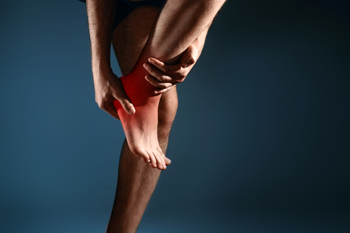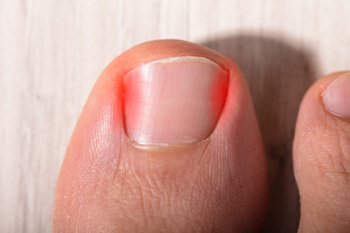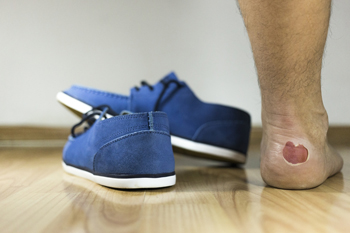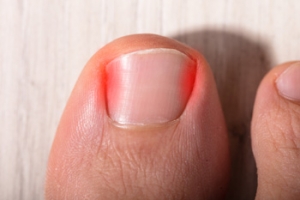Connect With Us
Blogs
Super User
Many People Experience Foot Pain

Many people experience foot pain at some point in their lives. Research has indicated that approximately 75,000 miles have been walked by the age of 50, and the likelihood is high that foot pain can develop. A common foot condition is athlete’s foot, and this is contagious. It is caused by a fungus that lives and thrives in warm and moist environments including shower room floors, public swimming pools, and locker rooms. Blisters can be quite uncomfortable and may develop from wearing shoes that do not fit correctly. A bunion is defined as a bony lump on the side of the big toe and is considered to be a deformity. Bunions can occur as a result of genetic factors or from wearing shoes that do not have adequate room for the toes to move freely. If the bunion is severe, surgery may be required for permanent removal. Another popular ailment is heel pain, which is most frequently caused by plantar fasciitis. Children can also develop heel pain known as Sever’s disease. Gout is said to be more prevalent among men and typically results from having excess uric acid in the blood. This causes crystals to form in the joints of the big toe and can cause debilitating pain. If you have any foot pain, it is strongly advised that you are under the care of a podiatrist who can properly diagnose and treat your condition.
Foot Pain
Foot pain can be extremely painful and debilitating. If you have a foot pain, consult with one of our podiatrists from Brondon Foot and Ankle. Our doctors will assess your condition and provide you with quality foot and ankle treatment.
Causes
Foot pain is a very broad condition that could be caused by one or more ailments. The most common include:
- Bunions
- Hammertoes
- Plantar Fasciitis
- Bone Spurs
- Corns
- Tarsal Tunnel Syndrome
- Ingrown Toenails
- Arthritis (such as Gout, Rheumatoid, and Osteoarthritis)
- Flat Feet
- Injury (from stress fractures, broken toe, foot, ankle, Achilles tendon ruptures, and sprains)
- And more
Diagnosis
To figure out the cause of foot pain, podiatrists utilize several different methods. This can range from simple visual inspections and sensation tests to X-rays and MRI scans. Prior medical history, family medical history, and any recent physical traumatic events will all be taken into consideration for a proper diagnosis.
Treatment
Treatment depends upon the cause of the foot pain. Whether it is resting, staying off the foot, or having surgery; podiatrists have a number of treatment options available for foot pain.
If you have any questions, please feel free to contact our office located in Centerville, OH . We offer the newest diagnostic and treatment technologies for all your foot care needs.
Elderly and their Feet
While proper foot care is important for everybody, senior citizens have the tendency to be more susceptible to certain foot conditions. The elderly should therefore be well informed about any problems that may arise and about what they can do to properly avoid or treat them.
Some of the most common foot problems seniors are susceptible to include foot ulcers, ingrown toenails, fallen arches, and fungal nails. A foot ulcer is an open sore on the foot and can be a result of diabetes and decreased sensation in the feet. An ingrown toenail is defined as when the nail grows into the side of the toe. Fallen arches are indicated by the instep of the foot collapsing. A fungal nails is a condition that results in deformed and discolored toenails.
In order to avoid these conditions it is recommended that the feet be inspected by the patient on a regular basis. If these inspections are carried out routinely, there is a good likelihood that problems can be identified before they become severe, or can even be avoided altogether. If any abnormality is discovered, it is important that the individual consult a podiatrist for diagnosis and information on treatment options.
Proper foot hygiene is also important. Making sure that you always have clean, dry socks on can be a major deterrent to many different problems including bacterial infections, foot odor, and certain types of fungus. Wet feet are a major cause of many of these problems. If your socks get wet, it is important to change them. Walking around in wet socks may not only lead to various infections, but can irritate the skin and result in a number of various complications. Clean, dry feet are less likely to be affected by fungal and other infections.
As people age, the fat present on your feet begins to deteriorate. The protective nature of this fat keeps the feet healthy by providing a barrier between your bones and the ground. This also aids in giving the skin on the feet a certain amount of elasticity. This is one factor that causes elderly people to develop some serious foot issues. Foot moisturizers can be helpful to avoid certain problems associated with this. However, water-based moisturizers do not work as well for elderly people as they do for the young. Instead, it is more effective to use an emollient instead. An emollient is effective because it binds the water in the foot, keeping it from becoming absorbed too readily which will result in dry skin. Emollients also have a special property called occlusion, which provides a layer of oil on the skin. This layer prevents the foot from drying up and can be very effective in treating dry skin disorders. If you can keep the skin on your feet healthy, this will substantially reduce the number of foot problems you will encounter in old age.
Proper footwear is another way to keep feet healthy. Shoes that fit well and provide proper support help prevent ingrown toenails and fallen arches.
Certain medical conditions such as diabetes or poor blood circulation increase the risk for foot issues. For individuals with any of these conditions it is extremely important to conduct regular foot inspections to make sure that there are no sores or infections present.
When an Ingrown Toenail Becomes Dangerous
I ngrown toenails can occur in individuals of all ages when the side of the nail digs into the skin. This condition is most prevalent in one’s big toe and will cause pain, discomfort, and redness where the ingrown nail meets the skin. Although the causes of ingrown toenails are varied, this condition frequently occurs due to improper nail care. If a toenail is cut too short, for example, the skin on the side of the nail can grow over top of the nail, eventually making it ingrown. Ingrown toenails can also develop when a toenail completely falls off following a serious foot injury or when the nail is severely ripped or misshapen. Some ingrown toenails—notably, milder ones—do not require immediate medical attention. However, making yourself aware of ingrown toenails is important to maintaining healthy feet because this condition can quickly become dangerous. Ingrown toenails may sometimes become infected, producing pus, swelling, warmness, and even unpleasant odors where the ingrown nail meets the skin. Letting such an infection go untreated may exacerbate the condition and the pain felt in the toenail. Upon receiving proper medical attention, your ingrown nail may be cared for by draining pus or removing sections of the ingrown nail. It is suggested you consult with your podiatrist if you feel an ingrown toenail is getting serious.
ngrown toenails can occur in individuals of all ages when the side of the nail digs into the skin. This condition is most prevalent in one’s big toe and will cause pain, discomfort, and redness where the ingrown nail meets the skin. Although the causes of ingrown toenails are varied, this condition frequently occurs due to improper nail care. If a toenail is cut too short, for example, the skin on the side of the nail can grow over top of the nail, eventually making it ingrown. Ingrown toenails can also develop when a toenail completely falls off following a serious foot injury or when the nail is severely ripped or misshapen. Some ingrown toenails—notably, milder ones—do not require immediate medical attention. However, making yourself aware of ingrown toenails is important to maintaining healthy feet because this condition can quickly become dangerous. Ingrown toenails may sometimes become infected, producing pus, swelling, warmness, and even unpleasant odors where the ingrown nail meets the skin. Letting such an infection go untreated may exacerbate the condition and the pain felt in the toenail. Upon receiving proper medical attention, your ingrown nail may be cared for by draining pus or removing sections of the ingrown nail. It is suggested you consult with your podiatrist if you feel an ingrown toenail is getting serious.
Ingrown toenails can become painful if they are not treated properly. For more information about ingrown toenails, contact one of our podiatrists of Brondon Foot and Ankle. Our doctors can provide the care you need to keep you pain-free and on your feet.
Ingrown Toenails
Ingrown toenails occur when a toenail grows sideways into the bed of the nail, causing pain, swelling, and possibly infection.
Causes
- Bacterial infections
- Improper nail cutting such as cutting it too short or not straight across
- Trauma to the toe, such as stubbing, which causes the nail to grow back irregularly
- Ill-fitting shoes that bunch the toes too close together
- Genetic predisposition
Prevention
Because ingrown toenails are not something found outside of shoe-wearing cultures, going barefoot as often as possible will decrease the likeliness of developing ingrown toenails. Wearing proper fitting shoes and using proper cutting techniques will also help decrease your risk of developing ingrown toenails.
Treatment
Ingrown toenails are a very treatable foot condition. In minor cases, soaking the affected area in salt or antibacterial soaps will not only help with the ingrown nail itself, but also help prevent any infections from occurring. In more severe cases, surgery is an option. In either case, speaking to your podiatrist about this condition will help you get a better understanding of specific treatment options that are right for you.
If you have any questions please feel free to contact our office located in Centerville, OH . We offer the newest diagnostic and treatment technologies for all your foot and ankle needs.
Ingrown Toenail Care
An ingrown toenail is a nail that has curved downward and grows into the skin. This typically occurs at the nail borders, or the sides of the nail. As a result, pain, redness, swelling, and warmth may occur in the toe. If a break in the skin forms due to the ingrown nail, bacteria may enter and cause an infection in the area; this is typically characterized by a foul odor and drainage.
Ingrown toenails have multiple reasons for developing. In many instances, the condition is a result of genetics and is inherited. The most common cause, however, is improper trimming; cutting the toenails too short forces the skin beside the nail to fold over. An ingrown toenail can also develop due to trauma, such as stubbing the toe, having an object fall on the toe, or participating in activities that involve repeated kicking or running. Wearing shoes that are too tight or too short can also cause ingrown toenails.
Treatment for an ingrown toenail varies between patients and the severity of the condition. Milder cases that don’t involve infection or other medical conditions can benefit from soaking the feet in room-temperature water and gently massaging the side of the nail. In most cases, however, it is best to see your podiatrist for thorough and proper treatment. After examining your toe, your podiatrist may prescribe oral antibiotics to clear the infection if one is present. Surgical removal of either a portion of the nail or the entire nail may also be considered. In some cases, complete removal or destruction of the nail root may be required. Most patients who undergo nail surgery experience minimal pain afterward and can return to normal activity the following day.
Ingrown toenails can be prevented with proper nail trimming and by avoiding improper-fitting shoes. When cutting the toenails, be sure that you are cutting in a straight line and avoid cutting them too short. Shoes should not be too short or tight in the toe box.
What to Do About Blisters Between the Toes

A blister is a fluid-filled bubble that forms on the skin. Most often these blisters are caused by one toe repeatedly rubbing against another toe or the lining of a shoe and irritating the skin. These are referred to as friction or pinch blisters and can typically be treated at home. Wearing shoes that fit properly, keeping feet clean and dry, and not walking barefoot in warm, humid areas can help prevent friction blisters from forming. It is important not to pop or pick at a blister as it can become infected, but if it has broken, toes should be soaked in clean, warm water and Epsom salts. If you are unsure which type of blister has formed, you suspect an infection, or if the friction blister is not healing within a reasonable time, it is suggested you consult with a podiatrist to have it evaluated, treated, and to learn how the formation of your blisters can be prevented.
Blisters are prone to making everyday activities extremely uncomfortable. If your feet are hurting, contact one of our podiatrists of Brondon Foot and Ankle. Our doctors can provide the care you need to keep you pain-free and on your feet.
Foot Blisters
Foot blisters develop as a result of constantly wearing tight or ill-fitting footwear. This happens due to the constant rubbing from the shoe, which can often lead to pain.
What Are Foot Blisters?
A foot blister is a small fluid-filled pocket that forms on the upper-most layer of the skin. Blisters are filled with clear fluid and can lead to blood drainage or pus if the area becomes infected.
How Do Blisters Form?
Blisters on the feet are often the result of constant friction of skin and material, usually by shoe rubbing. Walking in sandals, boots, or shoes that don’t fit properly for long periods of time can result in a blister. Having consistent foot moisture and humidity can easily lead to blister formation.
Prevention & Treatment
It is important to properly care for the affected area in order to prevent infection and ease the pain. Do not lance the blister and use a Band-Aid to provide pain relief. Also, be sure to keep your feet dry and wear proper fitting shoes. If you see blood or pus in a blister, seek assistance from a podiatrist.
If you have any questions, please feel free to contact our office located in Centerville, OH . We offer the newest diagnostic and treatment technologies for all your foot care needs.



